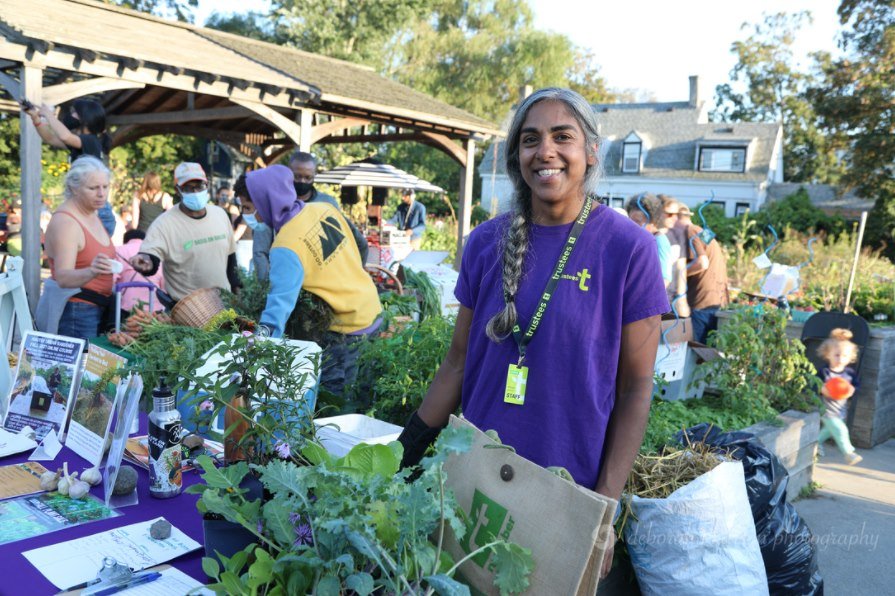Boston community gardens: A season of reconnecting
Trustees Community Gardens Engagement Manager Michelle de Lima (Courtesy Deborah J Karson)
New events and opportunities to reconnect were the hallmark of this year’s gardening season, on the heels of last summer’s challenges and limitations. Not only providers of fresh produce for hundreds of families and their social networks, community gardens are also valuable neighborhood spaces and centers for social activity, which this season was able to take full advantage of. The 56 community gardens managed by The Trustees in the City of Boston are spread out across eight neighborhoods: Dorchester, East Boston, the Fenway, Jamaica Plain, Roxbury, Mattapan, Mission Hill, and the South End—oases of green tended and cared for by local residents. This week, One Waterfront spoke with Trustees Community Gardens Engagement Manager Michelle de Lima to learn about this summer’s events, favorite moments, and hopes for next season.
Q: Last summer was a very strange and difficult season but the community gardens really rose to the challenge in finding ways to connect and keep that sense of community. How would you describe this season?
This season I think everyone had time to adapt a little more to the challenges of navigating a pandemic, and took advantage of the gardens being a relatively safe place to gather. As our understanding of the science progressed some, we all realized that these are some of the best places we could be together, interact and meet other people. People were less hesitant about safely gathering outside and the gardens were an amazing place to find something constructive and personally rewarding to do amidst this continuing sense of uncertainty. The gardens were places people could escape to, places that felt hopeful and good—the way gardening does no matter what is going on. It’s therapeutic and real.
Green New Dance Party, Nightingale Community Garden (Courtesy Deborah J Karson)
Q: What were you able to do this year that you weren’t last year?
One big difference for us in terms of programming and events was the outdoor events size restrictions being lifted. We’re still tailoring programs to the size of the garden and being cautious about how many people to have in a garden space at one time. But we were able to do events that allowed walk-ins, while still having plenty of space. We found that not having to require only pre-registered guests created a different vibe—people could stop in on a whim, and it felt more celebratory and relaxed. People were so happy to take part in concerts and other social gatherings in safe outdoor spaces. At our Green New Dance Party at Nightingale Community Garden, I spoke to several guests who lived in Dorchester but were coming inside the garden for the first time. Having music, and a food, and people coming and going really brings the gardens to people’s attention. That happened in July at our Eastie EcoFest at Joe Ciampa community garden, too. The added festivities of an event draw in people who haven’t been there before, and then they walk around and learn more about what’s going on, and how they can be a part of it.
Q: How do you see these gardens build community?
I’ve been in this role for seven years, and I’ve seen it happen at many different levels. Everything from casual acquaintances, where people meet each other because someone’s working at a plot and someone else is walking by, which happens a lot. You see people there, and you’re outside and there’s something to talk about—"what are you growing?” … “that flower is beautiful” … “Do you want an extra tomato?” —these kinds of conversations happen naturally around gardens. They open simple conversations that can lead to something else, which is really valuable especially right now in our isolated Zoom society. Then, when people come into the garden for a program or to become a garden member, those relationships can really deepen. I hear a lot from gardeners that they talk to their neighbors much more than they would have without the garden, and that they run into people they wouldn’t normally meet in their other social scenes. Gardens also create a gathering space where various neighborhood groups can have meetings, school groups can visit, and folks can come together to listen to music or poetry, learn about sustainability efforts, or share food together.
Q: What was new this year?
One of the most exciting events of the year was our Juneteenth event at Nightingale. It was the first time that we’ve celebrated it formally in the gardens, and the first time it was an official holiday. It was really great, we did it in what felt like a really authentic way, letting the gardeners lead and having local, Black, food vendors and musicians, and Boston’s Acting Mayor Kim Janey, which felt very special. There were a lot of people there, enjoying the day, in a jubilant mood. The spoken word poet and the musicians did address the huge amount of work that we as a society still have to do, towards racial justice. Still, it was nice amidst everything else going on, that there was something to celebrate, there is some progress happening here. I think people were feeling really joyful in a way that felt different and like a big release from a lot of the lockdown feeling of the year and half before that.
Juneteenth event, Nightingale Community Garden (Courtesy Deborah J Karson)
Q: Can you share a favorite moment with me, from this summer?
We had field trips this year, some Audubon campers from Drumlin Farm in Lincoln and the Boston Nature Center in Mattapan came weekly for six weeks to Nightingale Garden in Dorchester. One kid walked in and said loudly, “it smells amazing in here, it smells like nature!” I really just loved that. Connecting these kids to the garden was a fun thing that we haven’t done with that kind of regularity before. We really got into a rhythm and each time they learned and discovered new things.
Nightingale Community Garden (Courtesy Deborah J Karson)
Q: What is grown in the community gardens, and where does this produce go?
People grow pretty much anything that you could grow in New England. There are some crops that are particularly impressive to see people getting them to produce in this climate. This season was tough—we had a very wet year and a cold spell when crops went out in May. There were a lot more fungal diseases too, but I was really impressed with what I saw. In terms of crops that are grown, it runs the gamut and varies from plot to plot and garden to garden. Everything from greens to root crops and herbs…then the plots explode with the warm weather crops like tomatoes, peppers, cucumbers, squash, melons. When I say those things you might think, “oh butternut squash…” but there’s a huge variety, especially in squashes, hot peppers, and greens, depending on where people are from and what they like to eat. I did see more cucamelons this year, and I’ve seen a greater variety of greens. There were always a lot of Asian varieties of greens being grown but I think more people are realizing they are cold hardy and heat tolerant and delicious and easy to grow, so I’m seeing more of those being grown now, too. In our gardens everyone grows for themselves, their families, and whoever they want to share with. There tends to be an abundance at certain times of the year and a lot of the gardens do formal donations to a food pantry or less formal to neighbors. One of the gardens put something out they called an “abundance basket,” which was getting filled and emptied all season. So the produce is going to very local hunger relief efforts, and to the people who have the plots.
Q: Tell me some of your hopes for next season—and what people can do if they want to get involved.
I’m very happy with what we’ve done so far around having more people who have never been to the gardens come and have enriching and engaging experiences where they get to meet neighbors, and enjoy celebratory, environmental, and community organizing events. I want to build on that. We did that in Dorchester, East Boston and JP this past summer and I want to expand that to more neighborhoods. It’s important for us to reach more people who haven’t been in these spaces before or haven’t felt invited to enjoy and use the gardens, while still being respectful that these are primarily places for people to grow food. We did some bilingual programming this year and I’d like to do more of that. More broadly I want to focus on how our programs can be more accessible in various ways, making sure that people are feeling welcome and comfortable in the gardens. Folks can learn about in-garden and virtual programs and events at www.thetrustees.org/seedsow or can reach out to communitygardens@thetrustees.org to get involved in the gardens, programs, or volunteering.




